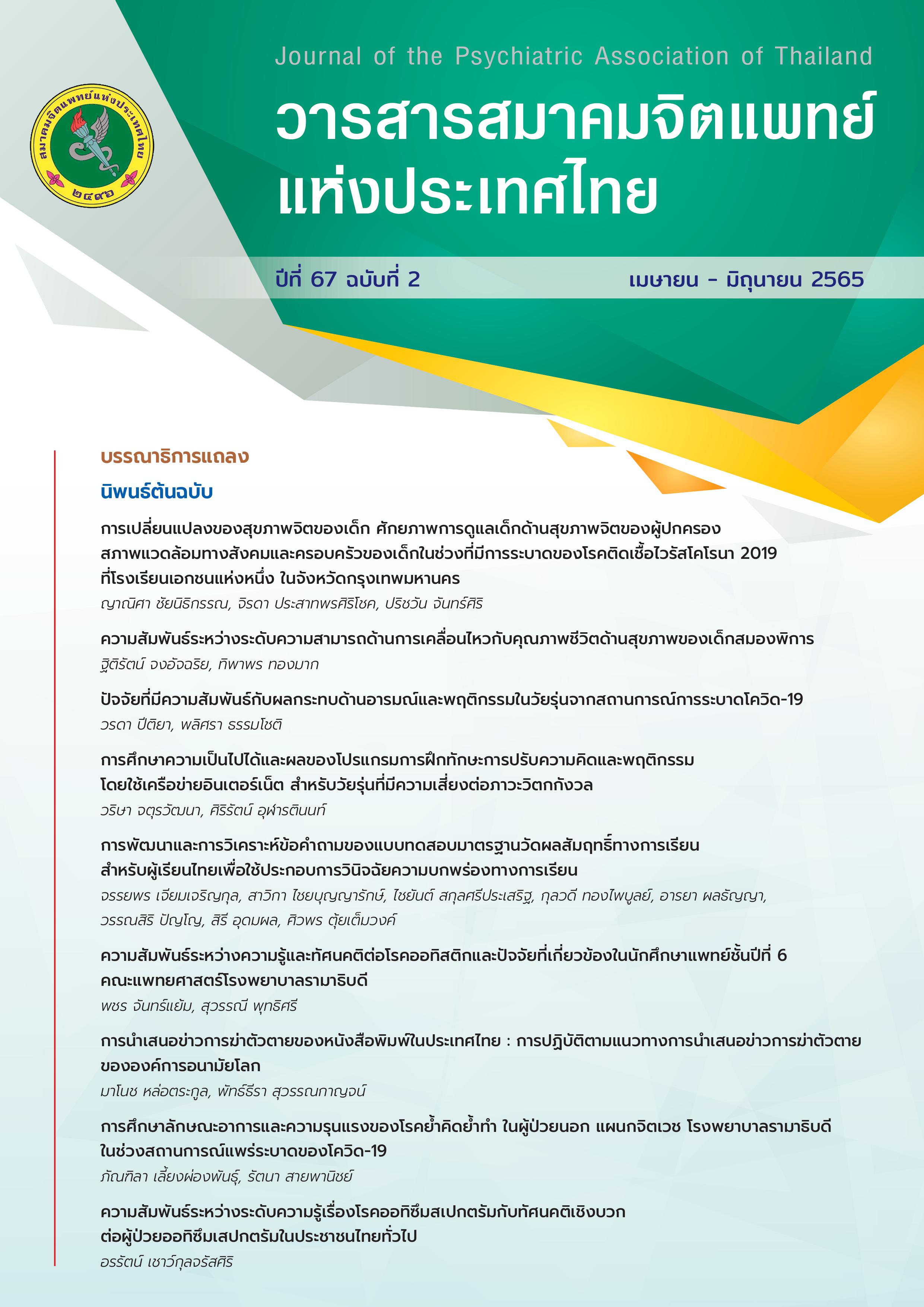ความสัมพันธ์ระหว่างระดับความสามารถด้านการเคลื่อนไหวกับคุณภาพชีวิตด้านสุขภาพของเด็กสมองพิการ
Main Article Content
บทคัดย่อ
บทคัดย่อ
วัตถุประสงค์ : เพื่อศึกษาความสัมพันธ์ระหว่างระดับความสามารถด้านการเคลื่อนไหวกับคุณภาพชีวิตด้านสุขภาพของเด็กสมองพิการ
วิธีการ : เป็นการเก็บข้อมูลแบบภาคตัดขวาง ณ เวลาใดเวลาหนึ่ง โดยเก็บข้อมูลจากผู้ปกครองหรือผู้ดูแลหลักของเด็กสมองพิการอายุ 4-12 ปี ที่เข้ารับการรักษาแบบผู้ป่วยนอกที่คลินิกเวชกรรมฟื้นฟู และคลินิกกุมารเวชกรรม โรงพยาบาลหาดใหญ่ ตั้งแต่วันที่ 1 พฤษภาคม 2562 ถึง 30 เมษายน 2563 เครื่องมือที่ใช้ในการเก็บข้อมูล ประกอบด้วยแบบบันทึกข้อมูลทั่วไปของผู้ป่วยและผู้ปกครองหรือผู้ดูแลหลัก แบบสอบถามคุณภาพชีวิตของเด็กสมองพิการ สำหรับผู้ปกครองหรือผู้ดูแลหลัก ฉบับภาษาไทย และระดับความสามารถด้านการเคลื่อนไหวจำแนกตามระบบ Gross Motor Functional Classification System Expanded and Revised (GMFCS – E&R) วิเคราะห์ข้อมูลทั่วไปด้วยสถิติเชิงพรรณนาและหาความสัมพันธ์ด้วยสถิติสัมประสิทธิ์สหสัมพันธ์แบบสเปียร์แมน
ผล: เด็กสมองพิการจำนวน 51 รายมีอายุเฉลี่ย7.3 ± 1.9 ปีส่วนใหญ่เป็นเพศชาย ร้อยละ 68.8 สำหรับระดับความสามารถด้านการเคลื่อนไหว พบความสามารถระดับที่ 1 และ 4 สูงสุด คือ ร้อยละ 29.4 รองลงมา คือ ระดับที่ 5 ร้อยละ 21.6 ผู้ปกครองหรือผู้ดูแลหลักอายุเฉลี่ย 37.7 ± 9.1 ปี ส่วนใหญ่เป็นเพศหญิง ร้อยละ 75.5 จากการประเมินคุณภาพชีวิตด้านสุขภาพ พบค่าคะแนนเฉลี่ยคุณภาพชีวิตด้านความเป็นอยู่ที่ดีและการยอมรับทางสังคมสูงที่สุด คือ 868.6 ± 142.3 คะแนน และคะแนนเฉลี่ยคุณภาพชีวิตด้านความเจ็บปวดและผลกระทบของการมีความพิการต่ำที่สุด คือ 200.0 ± 145.2 คะแนน และพบว่าระดับความสามารถด้านการเคลื่อนไหวของเด็กสมองพิการยิ่งน้อย มีความสัมพันธ์ทางลบกับคะแนนคุณภาพชีวิตด้านสุขภาพโดยรวมอย่างมีนัยสำคัญทางสถิติ (r = -.554, p<.01)
สรุป : เด็กสมองพิการที่มีความสามารถทางการเคลื่อนไหวน้อยจะมีคุณภาพชีวิตด้านสุขภาพโดยภาพรวมต่ำ ผลการศึกษาครั้งนี้มีประโยชน์สำหรับแพทย์ผู้รักษาในการวางแผนการรักษาผู้ป่วยให้ครอบคลุมทุกด้าน เพื่อช่วยเพิ่มระดับคุณภาพชีวิตของผู้ป่วยให้ดียิ่งขึ้น
Article Details

อนุญาตภายใต้เงื่อนไข Creative Commons Attribution-NonCommercial-NoDerivatives 4.0 International License.
บทความที่ส่งมาเพื่อพิจารณา ต้องไม่เคยตีพิมพ์หรือได้รับการตอบรับให้ตีพิมพ์ในวารสารฉบับอื่น และต้องไม่อยู่ระหว่างการส่งไปพิจารณาในวารสารอื่น
เอกสารอ้างอิง
Rosenbaum P, Paneth N, Leviton A, Goldstein M, Bax M, Damiano D, et al. A report: the definition and classification of cerebral palsy April 2006. Dev Med Child Neurol Suppl 2007; 109:8-14.
Colver A, Fairhurst C, Pharoach PO. Cerebral palsy. Lancet 2014; 383:1240-9.
Thongmak T, Jongutchariya T. Risk factors and associated disorders of cerebral palsy in pediatric patients in Hatyai hospital. Thai J Ped 2019; 58:95-102.
Cerebral palsy Alliance. Gross Motor Function Classification System (GMFCS). [Internet] [cited 2019 Jun 1]. Available from:
Siritaratiwat W, Thomas I. GMFCS- E&R Thai Translation. [Internet]. 2007. [cited 2019 Jun 1]. Available from: http://canchild.
ca/system/tenon/assets/attachments/000/000/081/original/GMFCS-ER Translation-Thai.pdf.
Gorter JW, Rosenbaum PL, Hanna SE, Palisano RJ, Bartlett DJ, Russell DJ, et al. Limb distribution, motor impairment, and functional classification of cerebral palsy. Dev Med Child Neurol 2004; 46(7):461-7.
Beckung E, Carlsson G, Carlsdotter S, Uvebrant P. The nature history of gross motor development in children with cerebral palsy aged 1 to 15 years. Dev Med Child Neurol 2007; 49(10):751-6.
Tessier DW, Hefner JL, Newmeyer A. Factors Related to Psychosocial Quality of Life for Children with Cerebral palsy. Int J Pediatri [Internet]. 2014. [cited 2019 Mar 1]. Available from: http://dx.doi.org/10.1155/2014/204386.
Davis E, Shelly A, Waters E, Davern M. Measuring the quality of life of children with cerebral palsy: comparing the conceptual differences and psychometric properties of three instruments. Dev Med Child Neurol 2010; 52(2):174-80.
Australasian Academy of Cerebral palsy and Developmental Medicine. The Cerebral Palsy Quality of Life Questionnaire. [Internet]. 2013 [cited 2019 Mar1]. Available from: http://www.Ausacpdm.org.au/
Kwanchanok S, Prasetsukdee S, Khajornchaikul P. Test-retest reliability and internal consistency of Cerebral Palsy Quality of Life Questionnaire (Thai version). Thai J Phys Ther 2014;36(2):60-9.
Pirpiris M, Gates PE, McCarthy JJ, D’Astous J, Tylkowksi C, Sanders JO, et al. Function and well-being in ambulatory children with cerebral palsy. J Pediatr Orthop 2006;26(1):119–24.
Vargus-Adams J. Health-related quality of life in childhood cerebral palsy. Arch Phys Med Rehabil2005;86(5):940–5.
Shelly A, Davis E, Waters E, Mackinnon A, Reddihough D, Boyd R,et al.The relationship between quality of life and functioning for children with cerebral palsy. Dev Med Child Neurol2008;50(3):199-203.
Liabsirinon S, Tantilipikorn P, Mahasup N. Interrater reliability of Thai version of gross motor function classification system (GMFCS) in Thai children with cerebral palsy. Thai J Phys Ther 2008;30(1):26-36.
Portney LG, Watkins MP. Foundations of Clinical Research: Applications to Practice. 2nd ed. Upper Saddle River, NJ: Prentice Hall, 2000.
Gharaborghe SN, Sarhady M, Hosseini SM, Mortazavi SS. Quality of life and gross motor function in children with cerebral palsy (aged 4-12). Iran Rehabilit J 2015;13(2):58-62.
Das S, Aggarwal A, Roy S, Kumar P. Quality of life in Indian children with cerebral palsy using cerebral palsy-quality of life questionnaire. J Pediatr Neurosci 2017;12:251-4.
Anggreany D, Saing JH, Deliana M, Dimyati Y. Comparison of the quality of life in cerebral palsy children with physical therapy more and less than 10 months. Paediatr Indones 2015; 55:287-92.
Mohammed FM, Ali SM, Mustafa MA. Quality of life of cerebral palsy patients and their caregivers: A cross sectional study in a rehabilitation center Khartoum-Sudan (2014 – 2015). J Neurosci Rural Pract 2016;7(3):355-61.
Livingston MH, Rosenbaum PL, Russell DJ, Palisano RJ. Quality of life among adolescents with cerebral palsy: What does the literature tell us? Dev Med Child Neurol 2007;49(3):225-31.
Liu WY, Hou YJ, Wong AM, Lin PS, Lin YH, Chen CL. Relationships between gross motor functions and health-related quality of life of Taiwanese children with cerebral palsy. Am J Phys Med Rehabil 2009;88(6):473-83.
Saka MJ, Odunewu MA, Saka AO, Akinwale SG, Anjorin OU. Quality of life of children with cerebral palsy: Accumulative effect of physiotherapy intervention in North Central and Southwest Nigeria. Afr J Physiother Rehabil Sci 2017;9(1-2):27-33.


